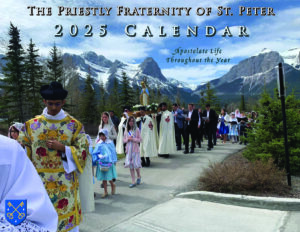Roman Forum Summer Symposium

2010 Summer Symposium, Gardone Riviera, Italy
Honoring the 100th Anniversary of Notre Charge Apostolique (August 15, 1910)
Letter of Pope St. Pius X to the Bishops of France on the Sillon
Dates: July 1st-July 12th (11 nights)
The Politics of Faith and Reason? Or the Triumph of the Will?
A basic either-or choice seems more and more to be forced upon contemporary Catholics. Either they accept as somehow written into the nature of things the dominant pluralist political, social and economic system, or they reaffirm their loyalty to a classical and Christian vision of man and society that clashes profoundly with it. What are the origins of that system? In what ways do classical and Christian political, social, and economic concepts contradict it? How is it that many believers have been falsely convinced that the pluralist system fulfills the Catholic vision? What can be done to drive home the truth that pluralism is an attack on both Faith and Reason and a recipe for the triumph of the will in public and private life? These are the themes to be developed by the Roman Forum faculty at the 2010 Summer Symposium.
Faculty, Clergy, Musicians
- Dale Ahlquist (President, American Chesterton Society)
- Dr. Miguel Ayuso-Torres (University of Madrid)
- Rev. Mgr. Dr. Ignacio Barreiro-Carmbula (Human Life International)
- James Bogle, Esq. (Author, A Heart for Europe)
- Dr. Jeffery Bond (Lecturer in Philosophy, Politics, and Literature) Dr. Danilo Castellano (University of Udine) Joshua Copeland (Chorister) Rev. Bernard Danber, O.S.A.
- Christopher A. Ferrara, J.D. (President, ACLA)
- David J. Hughes (Musical Director)
- James Kalb, Esq. (Author, The Tyranny of Liberalism)
- Michael J. Matt (Editor, The Remnant) Dr. Brian M. McCall (University of Oklahoma)
- Professor John Mdaille (University of Dallas)
- Dr. Robert Moynihan (Editor, Inside the Vatican)
- Rev. Dr. Richard Munkelt (University of Fairfield) Rev. Gregory Pendergraft, F.S.S.P.
- Dr. John C. Rao (St. Johns University)
- Rev. Richard Trezza, O.F.M.
(Plus other speakers from the US and Europe, to be announced)
Daily Program
Each day involves three lectures (morning and pre-dinner), and Sung Mass in the Extraordinary Rite (Tridentine Mass) at noon. There are no lectures on Sundays. Musical and theatrical entertainments take place in the garden of the Angeli in the evenings after dinner.
Cost
The full cost of the Gardone program in a double occupancy room is 2,000 Euros. This includes: tuition, room and board (very ample breakfast and dinner with wine, beer, and other beverages at will; all gratuities also); transportation to and from Malpensa Airport in Milan; a boat trip on Lake Garda; and excursions to Venice and in the Lake region. A number of full and partial scholarships are available.
Preference will be given to professors, students, clergy, and seminarians. Nevertheless, anyone who genuinely cannot afford the full tuition and believes himself to be a worthy candidate for assistance may apply.
Accommodations and the Setting
Accommodation and lectures for the Gardone program are at the Locanda agli Angeli and the Hotel Villa Sofia on Lake Garda, in the foothills of the Alps in northern Italy. Rooms are mostly doubles, with bath. A limited number of singles is also available. Both hotels are located in Gardone Sopra, a ten-minute walk from the lakefront, where free, clean beaches with a number of amenities can be found. They offer beautiful swimming pools and gardens on their premises. Meals are taken at the Angeli and at other trattorie several minutes walk away. Mass is in the parish church, also within walking distance. Arrangements to arrive earlier or stay later, at additional cost, may be made through the director.
Gardone is within easy traveling distance of Verona, Venice, Trent, Brescia, Milan, Ravenna, Pavia and Padua. In years past, participants have rented cars to tour the area, taken private and more extensive boat trips on the lake, attended the opera in Verona, and even ventured as far away as Florence. The region offers opportunities not only for swimming, but for hiking, biking, boating and scenic walks as well. The lectures are scheduled in such a way as to allow time for recreation and sightseeing.
Transportation
Transportation to Italy must be arranged privately. Two shuttles (morning and afternoon) to Gardone will be provided from Malpensa on July 1st, and one back to the airport on the morning of July 12th.
Participants arriving and leaving at different times or arriving at and leaving from different airports are responsible for making their own arrangements for getting to Gardone. Gardone can be reached by shuttle from the Airport to Milano Centrale (50 minutes), train to Brescia (50 minutes), and bus to Gardone Riviera (50 minutes), or by taxi from the airport (which can be very expensive).
Application
Applications can be e-mailed (drjcrao@aol.com) or sent by post. First time applicants only must include name, address, telephone number, e-mail, date of birth, occupation, academic degrees attained or pending, and the names and phone numbers of two references. Application should be made as soon as possible as there are only limited places available.
Payment
A non-refundable deposit of $500 will secure ones reservation. Once again, space is limited, so it is advisable to send this in as soon as possible after acceptance. Payment of the remaining fee, equivalent to 2,000 Euros as of May 1, 2010, must be made no later than May 15th, 2010. Deposits and all other payments must be made out to the Roman Forum and mailed to Dr. John C. Rao, 11 Carmine St. Apt. 2C, New York, NY 10014.
Final Notes
Seminar participants must eventually send us both their arrival and departure information. It is also important to let us know if you wish to arrive earlier or stay later than the scheduled symposium dates (at extra cost). We would appreciate this information by June 15th, by e-mail. A representative of the Roman Forum will meet participants at their arrival gates. Should the contact person not be found, please look for the bus driver holding a sign saying Molinari Agency, Gardone Riviera. His cell phone number will be sent to you by e-mail just before the departure date. In case of trouble, telephone the Locanda agli Angeli (from the USA, 011-39-0365-20991; from Italy, 0365-20991).
Barring the unpredictable, the weather should be sunny and quite warm/hot. We are in the foothills of the Alps, however, so one may need a sweater or light jacket for dining and sitting outside in the evening. Please also bring a light poncho or some other form of protection from a shower. If you do enjoy swimming and hiking, do not forget a bathing suit and good walking shoes. Tennis courts are available for use nearby. Access to the Internet is available from the Angeli, the Villa Sofia and the caf-restaurant La Taverna (the latter in the main square at Gardone Sopra, two minutes away from the Angeli).
There at ATM machines just outside the Angeli, and at the Banco di Brescia, a short distance away from the Villa Sofia.
Gardones greatest difficulty is laundry. There is no laundromat in the village. Someone does stop by every day to pick up any laundry that needs to be done, to be returned the next day. Under normal circumstances, laundry costs are expensive in Italy. With the dollar-euro exchange what it now is, it may be the greatest expenditure of your trip. There will be a general orientation at cocktail hour on Thursday, July 1st at the Angeli. A schedule of masses, as well as information about the Sunday boat trip and excursions during the week will be handed out at that time.
Contact Information
Please consider giving a tax-deductible donation to support clergy, seminarians, and students. Mail all applications and send donations to:
Dr. John C. Rao, Director
The Roman Forum
11 Carmine Street, # 2C
New York, NY 10014
Or e-mail to drjcrao@aol.com
January 25, 2010

Seminary Chapel To Be Consecrated

DENTON, Nebraska – January 22, 2010 – The Priestly Fraternity of Saint Peter is pleased to announce the Pontifical Consecration of its newly built chapel at Our Lady of Guadalupe Seminary on Wednesday, March 3rd at 10:00am (CST). Bishop Fabian Bruskewitz will celebrate the Pontifical Consecration and Mass according to the Extraordinary Form of the Roman Rite.
The five hour ceremony will be held in the presence of a very special guest from the Vatican, William Cardinal Levada, Prefect of the Congregation for the Doctrine of the Faith. The Priestly Fraternity of Saint Peter is delighted to have the presence of one of the highest ranking officials in the Catholic Church. Cardinal Levada’s presence is connected with his position as President of the Pontifical Commission Ecclesia Dei established by Pope John Paul II and recently expanded by Pope Benedict XVI to facilitate the full incorporation into the life of the Church of communities and individuals attached to the Extraordinary Form.
Thanks to Thomas Gordon Smith, its architect, the seminary chapel reflects a contemporary rebirth in the rich tradition of classical Catholic architecture. Upon entering through its mahogany doors, the visitor will be immersed in the chapel’s beauty and grandeur which include an elevated main altar, emphasized by a 31-foot marble canopy or “baldachino”, the chapel’s seven side altars and liturgical choir stalls which seat 92 seminarians and priests. These are some of the integral qualities of this chapel which, on March 3rd, will be full of the people for which it was made.
The Pontifical Consecration and Mass is open to all of the public. Any and all the faithful are cordially invited and are most welcome to attend this joyful event and enjoy refreshments afterward.
Due to the number of guests and limited space, rooms and television screens will be provided for those outside of the chapel who wish to participate.
The Pontifical Consecration and Mass will be televised live on the Eternal World Television Network (EWTN) at 11:00AM (EST). Watch the Pontifical Consecration and Mass Live Online!
Media Contact
Father Joseph Lee, FSSP
Our Lady of Guadalupe Seminary
7880 West Denton Road
Denton, Nebraska 68339
Phone (402) 570-2707

Camp St. Peter – June 18- July 2, 2010
 The Priestly Fraternity of St. Peter is hosting a two-week, outdoor summer camp for boys aged 12 to 15 years old, at Custer State Park, located an hour south of Rapid City, South Dakota. The camp will be staffed by one priest and six seminarians of the Fraternity of St. Peter. Custer State Park is located in the rugged Black Hill mountain range and offers plenty of opportunities for fishing, swimming, hiking, wildlife observation and land orientation skills. Sleeping arrangements will be in tents provided by the Fraternity. Bathroom facilities are available onsite, and shower facilities are located nearby. Additionally, a local high-school only a short distance away provides opportunities for various athletic games such as soccer, football, volleyball, and dodge-ball.
The Priestly Fraternity of St. Peter is hosting a two-week, outdoor summer camp for boys aged 12 to 15 years old, at Custer State Park, located an hour south of Rapid City, South Dakota. The camp will be staffed by one priest and six seminarians of the Fraternity of St. Peter. Custer State Park is located in the rugged Black Hill mountain range and offers plenty of opportunities for fishing, swimming, hiking, wildlife observation and land orientation skills. Sleeping arrangements will be in tents provided by the Fraternity. Bathroom facilities are available onsite, and shower facilities are located nearby. Additionally, a local high-school only a short distance away provides opportunities for various athletic games such as soccer, football, volleyball, and dodge-ball.
While the camp setting provides an incredible array of exciting activities, the most important function of the camp is spiritual. This camp should not be thought of as an entertaining summer adventure only, but as an opportunity to grow closer to God. The camp is intended to strengthen the faith of those who attend by providing instruction in the faith, and the virtuous example of men in the process of dedicating their lives to God. Every day, the boys will be expected to willingly participate in the Holy Sacrifice of the Mass, a group rosary, 20 minutes of meditation, and night prayer. Confession will be available almost every day. Campers can expect to receive classes on Catechism, Gregorian chant, and Mass serving.
Example Daily Schedule
05:30 Rise
05:45 Morning prayer & Confessions
06:15 Holy Sacrifice of the Mass
07:15 Breakfast & clean-up
08:00 Morning program
11:00 Rosary
11:30 Lunch
12:30 PM Afternoon program
5:30 Dinner
7:00 Evening program
9:30 Evening prayer & lights out
Registration and Application Information
Camp St. Peter 2010 will take place June 18th – July 2nd for boys between 12 – 15 years old. Special consideration this year will be given to those who have not yet attended the camp.
The cost for this years camp is $350, payable by check, which should be sent along with the application form. This check will only be deposited if your applicant is accepted. (Please send a separate check for each applicant.) A more detailed information packet will be mailed to you upon acceptance. God bless you, and please pray for discernment on the part of the selecting staff!
Applications must be mailed and postmarked no later than May 1st.
For more information and registration, please download our registration form.
You may also contact the camp director at fsspcamp@gmail.com
January 16, 2010

Priestly Ordination Conferred
Priestly Ordination of Rev. Mr. Jose Zepeda, F.S.S.P. has been conferred by Bishop Salvatore Cordileone. Deo Gratias!

The celebration took place December 19, 2009, at 11:00 A.M.
St. Jarlath Church
2620 Pleasant St.
Oakland, CA
http://www.stjarlath.org/home.html
For more info please contact OLGS at 402-797-4400.
Updated 1/11/2010 with photos of the event.




January 11, 2010

San Diego’s Beacon of Tradition
May 30, 2008, the Feast of the Sacred Heart of Jesus, was another special day for the San Diego Traditional Latin Mass Community, for it was on that day that one of its own—Fr. Jared McCambridge, FSSP—was ordained to the sacred priesthood. The following month Fr. McCambridge returned to the cemetery mausoleum chapel to offer the Holy Sacrifice of the Mass. It was during Fr. McCambridge’s visit that the idea of inviting the FSSP to assume responsibility
This article originally appeared in the June 2009 Fraternity Newsletter. To receive our free newsletter by mail, please click here.
October 7, 2008, the Feast of Our Lady of the Holy Rosary, was a special day for the San Diego Traditional Latin Mass
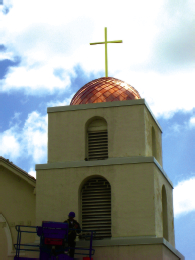
Community. On that day, the Most Reverend Robert H. Brom, Bishop of San Diego, erected St. Anne Catholic Church as a Personal Parish for the San Diego Traditional Latin Mass apostolate and entrusted the new parish to the Priestly Fraternity of St. Peter.
In six months, St. Anne’s has become a fully-functioning traditional parish. How this occurred reveals a remarkable partnership between the San Diego families who have long supported the Traditional Latin Mass and their new Pastor.
Beginning in 1985, San Diego families and those visiting San Diego had gathered once a week at a cemetery mausoleum chapel to share the blessings of “the most beautiful thing this side of heaven.” Nearly every Sunday after Mass many of the congregation remained to pray a second Rosary imploring the Immaculate Heart of Mary for her help that they might be granted their own traditional Latin Mass parish. Recognizing the need for priests committed to the Traditional Latin Mass, in 1994 the San Diego community initiated a Seminarian Burse, a monthly collection to support the formation of priests at the FSSP North American seminary. By 2008, more than $300,000 had been donated to Our Lady of Guadalupe Seminary. In 2007, efforts began to relocate the Traditional Latin Mass in San Diego to a parish church. St. Anne Church, a small church in the Logan Heights community, would in all likelihood be closed due to declining attendance and the lack of priests. It soon became the focal point of interest. At the urging of the community’s chaplain, the daily Traditional Latin Mass, which was begun on September 14, was moved to St. Anne’s in February 2008.
May 30, 2008, the Feast of the Sacred Heart of Jesus, was another special day for the San Diego Traditional Latin Mass Community, for it was on that day that one of its own—Fr. Jared McCambridge, FSSP—was ordained to the sacred priesthood. The following month Fr. McCambridge returned to the cemetery mausoleum chapel to offer the Holy Sacrifice of the Mass. It was during Fr. McCambridge’s visit that the idea of inviting the FSSP to assume responsibility
for the San Diego apostolate was nurtured. Subsequently, on July 31, Fr. Eric Flood, District Superior, met with Bishop Brom and accepted the Bishop’s invitation. In early September Fr. Carl Gismondi, FSSP, arrived and assumed responsibility for the San Diego apostolate.
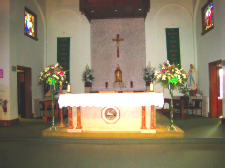
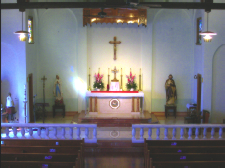
Under Fr. Gismondi’s leadership events quickly unfolded. St. Anne’s was a very old church, built in the early 1920s and in need of a great deal of repair and renovation. A bold plan was quickly developed and, in less than six months, major repairs including relocation of the altar, installation of a new marble floor and communion rail, and a new hardwood floor in the nave were completed. The physical changes to St. Anne’s were impressive, yet even more impressive was the rapid development of parish life— liturgical, catechetical and social.
A full parochial observance of the Sacred Liturgy, including three Masses on Sunday and at least one Mass each weekday, was provided. To extend a welcoming hand to former parishioners, Fr. Gismondi added a third Sunday Mass and made special arrangements to provide the Epistle, Gospel and Sermon in Spanish. With the assistance of the Brothers of the Little Oratory, the hours of the Divine Office are chanted as the occasion permits.
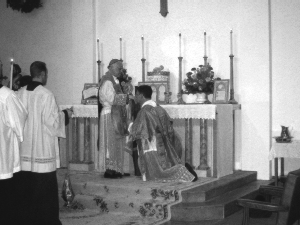
The parish’s first Christmas was made all the more joyful when San Diego’s Auxiliary Bishop, the Most Reverend Salvatore J. Cordileone, celebrated our first Christmas Midnight Mass. The first Easter brought with it the blessings of the Sacred Triduum in the Extraordinary Form—the first time in 40 years the San Diego community was able to observe the events of Our Lord’s suffering, death and resurrection in the Traditional form.
Recognizing that liturgical music is an indispensable part of the liturgy, under the direction of Fr. Gismondi and the parish Music Director, Mary Ann Carr Wilson, a liturgical music program involving Gregorian chant, sacred polyphony and other traditional hymns previously established was expanded to include the St. Anne Choir (the adult choir) and the St. Anne Choristers (a children’s choir).
Under Fr. Gismondi’s direction and with the help of Deacon Jose Zepeda, FSSP, a religious education program was begun including classes for adults, young adults and children. In June, the first class will receive their First Holy Communion.
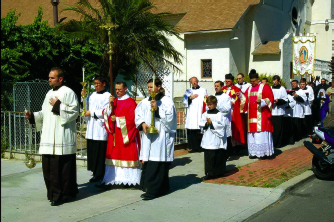
Under Fr. Gismondi’s direction, the parish devotional life was expanded to include two Holy Hours each week, a Sunday Rosary, a May crowning, First Saturday devotions to the Immaculate Heart of Mary, and monthly St. Padre Pio devotions. Parish life includes several lay organizations including the St. Anne Altar Society, the ladies of the parish who help maintain the parish facilities; St. Anne Youth Group; the St. Stephen’s Guild for Mass
Servers; and the parish Pro-life group, the San Diego Chapter of the Helpers of God’s Precious Infants.
December 21, 2009

A Reflection on Our Lady in Advent
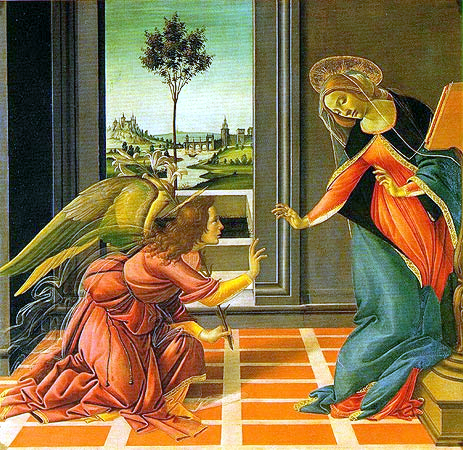 The Annunciation
The Annunciation
The following sermon was given during a recent Rorate Mass by Rev. Mr. John Rickert, FSSP. Deacon Rickert currently teaches at St. Gregory’s Academy in Elmhurst, PA.
The Angelic Salutation
Thou has found favor with God. ( Luke 1:30 )
As a culture we do not attribute much significance to particular numbers, and yet certain numbers do stand out as being especially symbolic or significant. The number 7, for example, signifies fullness, completion, or perfection, and is regarded by some, in some sense, as a happy or “lucky” number. And we see this both in the secular world and in religious themes. For example, Rome is the city of 7 hills and had 7 kings. There are, traditionally, 7 seas and 7 wonders of the world, and 7 liberal arts. In the Bible, we find a 7-day week with the 7th day being the Sabbath. In the New Testament, Our Lord multiplies 7 loaves of bread and yields 7 baskets of superabundance. In the Apocalypse, in particular, there are 7 churches, lamps, spirits, and seals, to name only a few. And, of course, we must mention the 7 Sacraments and the 7 gifts of the Holy Ghost. There are 7 petitions in the Our Father. As we said, 7 often times signifies fullness, perfection.
Now, in the “Hail, Mary” we see 7 salutations:
- Hail, Mary
- Full of grace
- The Lord is with thee
- Blessed art thou among women
- And blessed is the fruit of thy womb, Jesus
- Holy Mary
- Mother of God
This prayer is so familiar to all of us, we may simply take it for granted and not give enough thought to all that it is saying. Let us take some time to ponder each of these salutations.
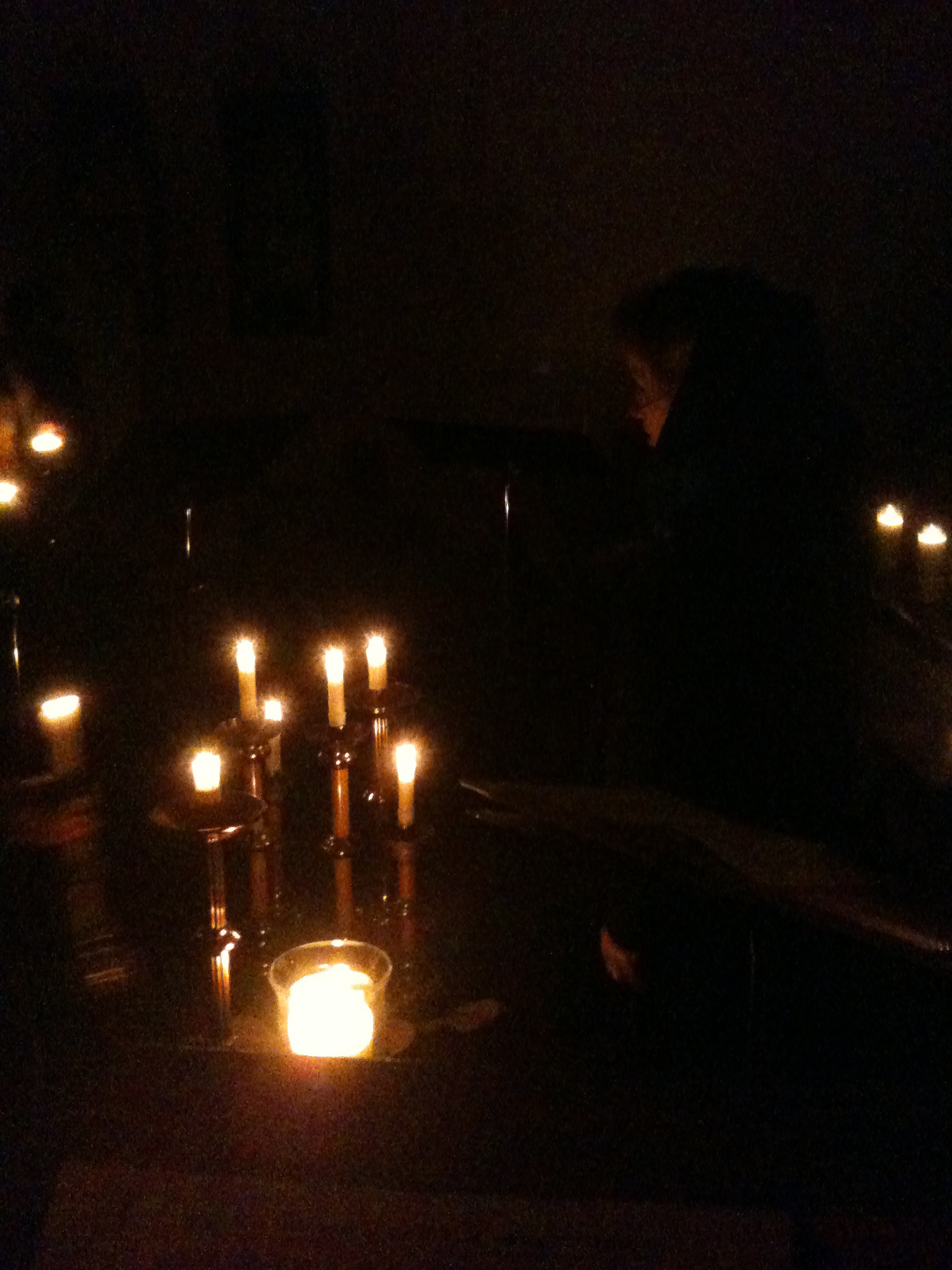
The Rorate Mass is said by candlelight. 1. Hail, Mary. The angel salutes her. The ordinary form of greeting is “peace – shalom”. We see this several times after the Resurrection of Our Lord: when He appears to His apostles He says, “Peace be with you,” shalom. But the verb used here is a salutation. It is also used, in 1 mockery, by those who crown the Lord with thorns and say, “Hail, King of the Jews.” The primary meaning of the word used here, though, is “to rejoice.” So, one could say that the angel is telling Mary to rejoice and be glad, because he brings a message of great joy. Let’s not forget this. We look at the world today, and it’s very bleak and and apprehensive.
Are we conforming to that spirit of the world, because it is submerged in its own gloom, or instead to the spirit of joy that comes from knowing of salvation, and who brings it?2. Full of grace – gratia plena. One of the oldest translations of the Bible that we have is into the language called Syriac, which is very closely related to the language that Jesus spoke on a daily basis, Aramaic. This translation we have in Syriac is important because of its antiquity and because of its Semitic understanding. Now, this version of the New Testament translates this phrase as “malyuth-taybuthá” which means, “full of grace,” but even more literally means “full of goodness.” Next to Our Lord, no one is as full of grace or goodness as Mary is. The greatness of Mary is surpassed only by the greatness of God Himself. Another point to mention here is that Mary is the daughter of St. Anne. Now, the name “Anne,” which is “Hannah” in Hebrew, means… grace. So, not only is Mary the Mother of Grace, she is the daughter of Grace: She is full of grace.
3. The Lord is with thee. And the Lord is with us. That is what we hear also today. For, the epistle tells us, “His name shall be ‘Emmanuel,’” which means “God with us.” It is crucial to understand something about the Hebrew way of thinking here, and this point is comes up many times through the course of the Bible. In Hebrew, the word davar means both word and thing, and we see this in today’s Gospel reading. The Gospel says, “Non erit impossibile apud Deum omne verbum.” Some translations say, “No word shall be impossible with God,” and others say, “Nothing shall be impossible.” ( Luke 1:37 )Either translation is acceptable, because, for the Hebrew mind, 2 word and thing are equivalent, and as a result of this, name and identity become equivalent.
This is especially clear in the book of Exodus. When Moses asks for God’s name, God tells him, “I am WHO AM.” Moses asks for God’s name, and God replies by telling Moses Who He is. So, back to today’s reading, God is with us, Emmanuel, Who was first with her: The Lord is with thee. One other observation: We can see there is no inconsistency in the message. The child of Mary is Emmanuel, because He is truly God-with-us, and He is Jesus, because He is the Savior. The different names bring out different aspects of one and the same reality.
4. Blessed art thou among women. In all of the New Testament, only two people are directly called blessed in addition to Our Lord Himself. There are descriptions of categories of people who are blessed, of course, such as the Beatitudes – blessed are the meek, blessed are the pure of heart, and so on – as well as other occasional designations – for example, blessed are they who hear the word of God and keep it. But in all the New Testament, only two particular people are called blessed: St. Peter when he confesses the divinity of Christ, and Mary, as we see here. In the Old Testament, there is a very striking passage where someone is called blessed: Judith in the book of Judith 13:18. 1 “O daughter, you are blessed by the Most High God above all other women on earth; and blessed be the Lord God, who created the heavens and the earth, who has guided you to cut off the head of the leader of our enemies. Your praise will never depart from the hearts of those who remember the power of God. May God grant this to be a perpetual honor to you, and may he reward you with blessings… you averted our ruin, walking in the straight path before our God.” And all the people said, “Amen! Amen!”
5. And blessed is the fruit of thy womb, Jesus. There is an implication here we need to draw out. In Matthew 7 Our Lord says: “By their fruits you shall know them… Even so, every good tree bringeth forth good fruit, and the evil tree bringeth forth evil fruit. A good tree cannot bring forth evil fruit, neither can an evil tree bring forth good fruit.” Jesus is the blessed fruit of Mary’s womb, so Mary herself must be good. She has never known sin in any moment of her existence.
6. Holy Mary. This would seem to need no comment, but it gives us a good opportunity to raise a very important point: Sancta sancte tractanda sunt. Holy things must be treated in a holy manner. Mary is holy, and images and representations of her are holy as well. Let us always be sure to treat them with reverence. Let us remember, too, that Mary is the mystical spouse of the Holy Ghost. As St. Luke tells us in today’s Gospel, “The Holy Ghost shall come upon thee and the power of the Most High shall overshadow thee. And therefore also the Holy whch shall be born of thee shall be called the Son of God.” To dishonor Mary is to dishonor her Mystical Spouse. Therefore, let us be especially careful to be reverent in our speech or actions regarding her: She is holy. Nor should we hesitate to defend her honor when we see it attacked.
7. Mother of God. This title of Mary was resisted by heretics and definitively approved by the Council of Ephesus in the year 431. In affirming this title, we affirm the divinity of Christ, the personal relationship of Mary as being truly His mother, and we reject the Nestorian heresy especially along with several others. Indirectly, in professing this great title, we stand by the authority of the Church to teach. After making these 7 beautiful and majestic salutations, we put make our request: Pray for us. Pray for us now, because we always need help, and she is the Mediatrix of all Graces. Pray for us when we are about to die, because without the grace of final perseverence, all other graces come to nought.
Conclusion
When we bear well in mind what we are praying for and whose help we are seeking to obtain it, we will pray with reverence, care, and love, and not in hurried, thoughtless, mechanical way. We remember that we are praying to a real, live person, a personal friend, the best friend we could ever have next to Our Lord Himself. May she who is full of grace and ever blessed, who has already done more for us than we realize, obtain for us every blessing, and above all, the supreme grace to be with her, and with the Father, the Son, and the Holy Ghost forever in heaven. Amen.
December 16, 2009

Rights (vs Responsibilities) – Natural Rights vs Civil Rights
 by Dennis Q. McInerny, Ph.D.
by Dennis Q. McInerny, Ph.D.
From the December 2009 Newsletter
More than once in times past I have made mention of the fact that we find in contemporary society an inordinate emphasis on rights, an inordinate emphasis which often takes the form of a positive obsession. The emphasis is inordinate—that is, disordered—because it is at bottom a gross overemphasis. Too much attention is given to rights, while much too little attention is given to the balancing factor of responsibilities. Indeed, sometimes responsibilities are ignored altogether, as if they were not deserving of our attention, or worse, as if they did not even exist. This is of course to have things all askew.
If I am constantly demanding my rights while pretending that I have no responsibilities, I am effectively cutting off my nose to spite my face, for rights are empty without accompanying responsibilities. If I can ignore my responsibilities with impunity, why can’t everyone else? But if everyone else ignores their responsibilities, I can kiss my rights goodbye. They might still be on the books, but only as dead letters. I can’t have it both ways. If I want my rights to be honored, then I must honor the rights of others; that is, I must acknowledge my responsibilities toward others, and live up to them.
How are we to explain this modern obsession with rights? It is to be explained in great part by the pervasive prevalence of individualism in our culture. What is individualism? It could be characterized as that way of thinking which attaches more importance to the individual than to any community to which the individual might belong, to the point where the very existence of a community, as a coherent entity, is threatened. The individual is of course important, we might even say supremely important, in the sense that each one of us is a beneficiary of the Redemption. But the individual is not important in the way individualism wants him to be—as someone who proudly cuts himself off from others, and even looks upon them as enemies, because he sees them as threatening what is rightfully his. The individualist always regards himself, without qualification, as Number One, above everybody else; his favorite pastime is screaming about his rights, while never letting out so much as a peep about his responsibilities. The individualist, in sum, is an arrogant egotist, for whom the three most important things in the world are Me, Me, and Me.
One of the specific manifestations of the aforementioned disordered emphasis on rights is the manufacturing of totally specious rights, such as the so-called right of a woman to kill her own child. In light of the egregious misuse of the concept of rights, in examples such as that, one might be prompted to ask if perhaps all rights are but fictions, made up by us for entirely self-serving purposes—purely subjective inventions, in other words—and which have no grounding in objective reality. That might strike you as an odd, if not downright preposterous, question, but it is one which has been asked by some prominent and justifiably respected philosophers, and answered in the affirmative. These philosophers take the view that what we call natural human rights simply do not exist; they are moral fictions, and the concept of rights is a pseudo-concept.
Other philosophers do not take so extreme a position. They begin by making a distinction between negative rights and positive rights, then acknowledge the reality of the former, while denying reality to the latter. A negative right is a right not to be deprived of something which is properly ours by dint of the natural law. The three negative rights most often cited in the literature are the rights to life, liberty, and property. Each of us has a right to life, in the basic sense that we are entitled by nature not to have it taken away from us. Examples of positive rights would be a right to a formal education, a right to medical care, a right to a living wage. Again, the philosophers we are considering here deny that there are any such rights. Why do they do so? They argue along these lines: if we grant that everyone has a right to medical care, for example, then, if that right is to have any meaning, there must be some entity that is able to guarantee the honoring of the right. Only government would be able to do so. And there is the rub, as far as they are concerned, for the more rights a government attempts to guarantee, the bigger and more powerful the government becomes, and these philosophers are very suspicious of big, powerful governments. (I happen to know one philosopher in this school who makes a single exception with respect to positive rights, arguing that every child has a right to be properly educated by his parents.)
What are we to make of all this? I think we should start by acknowledging that rights are indeed real; they are not mere fictions. Next, an important distinction has to be made between natural rights and civil rights. Natural rights are simply ours by nature; they belong to us simply because of who we are as rational creatures with an eternal destiny. These rights can properly be called inalienable; they cannot be taken away from us by any earthly power. This is not to say, however, that they cannot be dishonored, as witnessed by the fact that the right to life of millions of aborted babies has been grievously dishonored in recent years. Civil rights are simply those granted to us by civil society, such as the right of a lawyer to open a law office and solicit clients if he is duly licensed in the state in which he intends to practice.
Civil rights can be regarded as real in the plain, practical sense that they are, as a matter of fact, an integral, functioning part of any civil society. But on what basis can we contend that natural rights are real? One way to approach the question is to consider the ramifications of the actual practice of the virtue of justice. Justice is the virtue which tells us that we are to give to every person what is due to that person. Each of us, if we are to be just, has an obligation to meet the demands made of us by the virtue. That means that if I want to be just, say toward Person X, then I am under obligation to give to Person X what is owed to him. Now let’s look at it from the view point of Person X. If he, in justice, has something owed to him, does not that mean that he has a legitimate claim to it, that he is entitled to it, that, in a word, he has a right to it? It would seem so.
December 5, 2009

St. Michael’s, Scranton – Eucharistic Procession for Christ the King
The sounds of Christus Vincit and Pange Lingua filled the streets of Scranton, Pennsylvania once again as St. Michael’s Roman Catholic Church in West Scranton celebrated the Feast of Christ the King with its annual Eucharistic procession.
Afterwards, Father Gordon celebrated Benediction of the Blessed Sacrament. This was followed by a weekly Sunday breakfast in the basement of the church.
The procession is one of several held by the parish throughout the year. Local residents will typically come out on their porches while children and adults from the parish hand out Rosaries, holy cards, and Miraculous Medals. The processions serve as a great witness to the local community and each time a new route is taken. Earlier in October during the annual Rosary procession, the parish was allowed to process down Main Street while praying the Rosary.
The parish is very grateful to the Scranton Police Department for the escort and to all those who made the event a grand success.
For more information about St. Michael’s in Scranton please view our Diocese of Scranton Apostolate page.
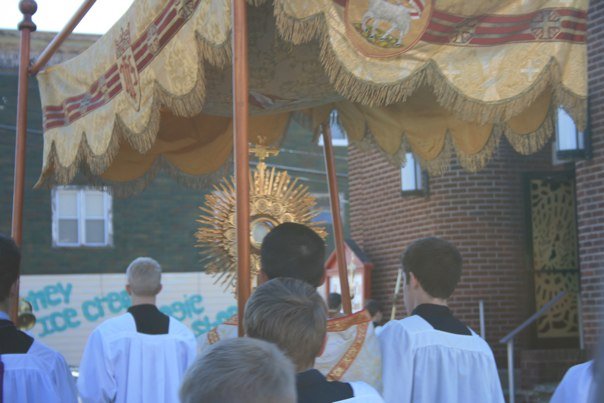
- Fr. Gordon begins the procession.
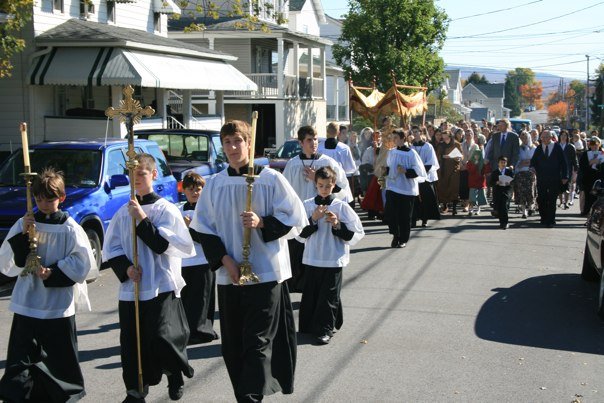
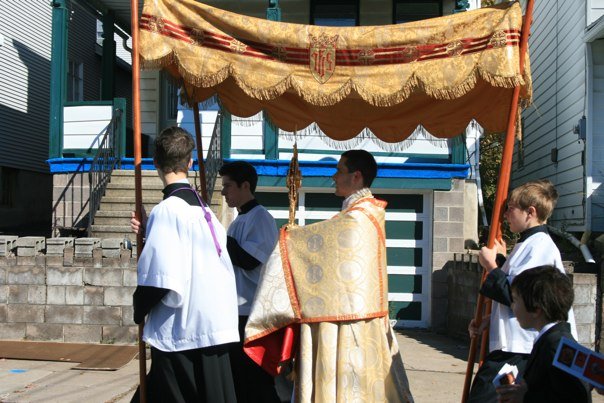

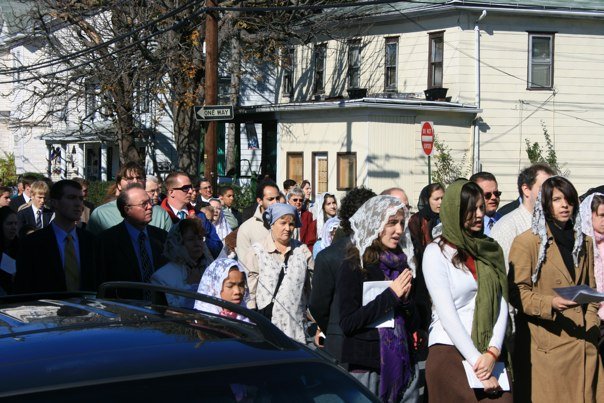
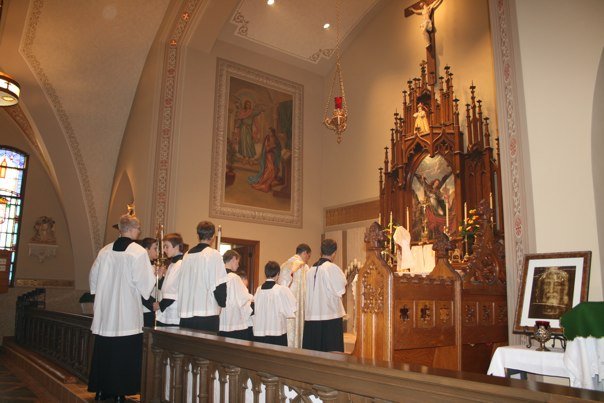
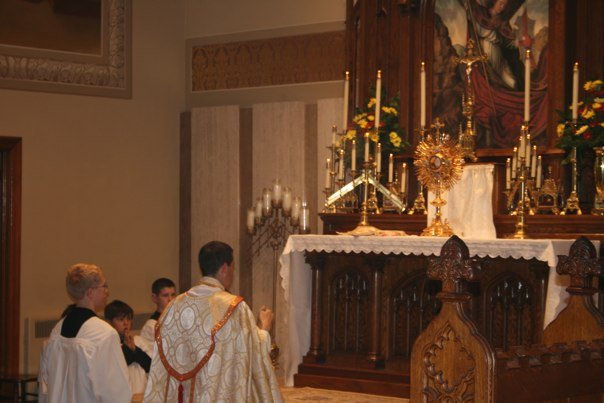
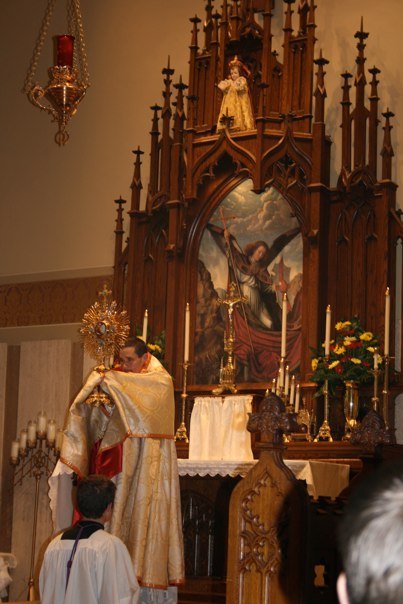
October 30, 2009

Fr. Robert Fromageot, FSSP to be on EWTN
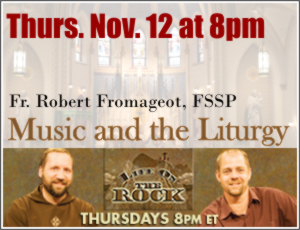 Fr. Fromageot, FSSP of Our Lady of Guadalupe Seminary in Denton, Nebraska will be appearing on EWTN’s Life on the Rock with Father Mark Mary and Doug Barry.
Fr. Fromageot, FSSP of Our Lady of Guadalupe Seminary in Denton, Nebraska will be appearing on EWTN’s Life on the Rock with Father Mark Mary and Doug Barry.
Father will be discussing Gregorian Chant and how it helps the liturgy fulfill its twofold end; namely, the worship of God and the sanctification of souls.
Channel: EWTN Global Catholic Network
Date: Thursday, November 12, 2009
Time: 8:00PM
About EWTN:
EWTN Global Catholic Network, in its 28th year, is available in over 150 million television households in more than 140 countries and territories. With its direct broadcast satellite television and radio services, AM & FM radio networks, worldwide short-wave radio station, Internet website www.ewtn.com and publishing arm, EWTN is the largest religious media network in the world.
For more information, go to:
http://www.ewtn.com/rock/index.asp
October 29, 2009

Minor Orders to be Conferred
Date: October 24
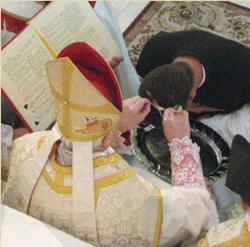
Tonsures and Subdeacon in Denton will be conferred by His Exc. Mgr. Fabian Bruskewitz, Bishop of Lincoln.
Please pray for the ordinands:
- Zachary Akers
- Eduardo Araujo
- Joshua Curtis
- Daniel Egan
- David Franco
- Daniel Heenan
- Tom Heffernan
- John Kodet
- Trevor Lontine
- Michael Malain
- Stephen Menard
- Timothy O‟Brien
- Thomas Schutzman
- Ian Verrier
Please pray for the future subdeacon Mr. Rhone Lillard.
For more information on this event, please contact Our Lady of Guadalupe Seminary:
seminary [at] fsspolgs.org
(402)797-7700
October 1, 2009









